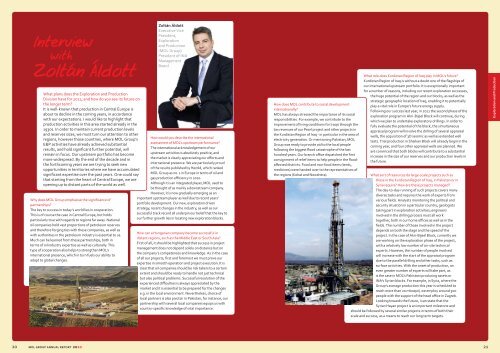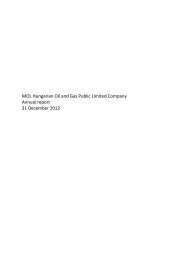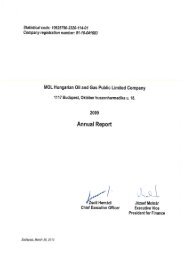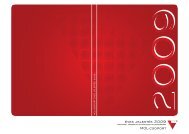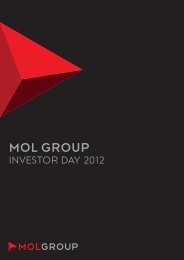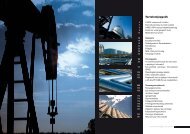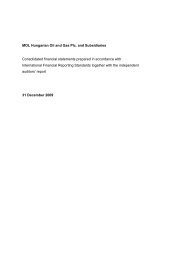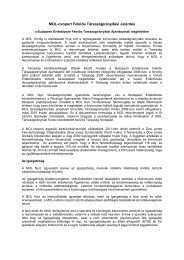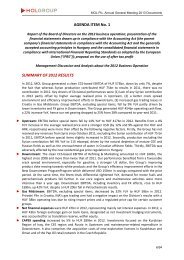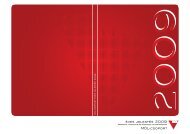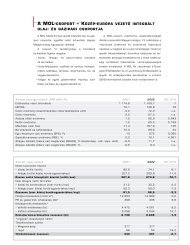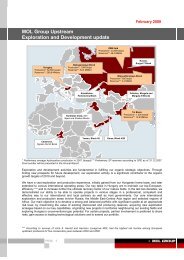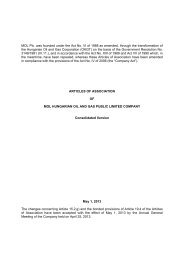MOL GROUP Annual Report
MOL GROUP Annual Report
MOL GROUP Annual Report
- No tags were found...
Create successful ePaper yourself
Turn your PDF publications into a flip-book with our unique Google optimized e-Paper software.
InterviewwithZoltán ÁldottWhat plans does the Exploration and ProductionDivision have for 2011, and how do you see its future onthe longer term?It is well-known that production in Central Europe isabout to decline in the coming years, in accordancewith our expectations. I would like to highlight thatproduction activities in this area started already in the1930s. In order to maintain current production levelsand reserves sizes, we must turn our attention to otherregions, however those countries, where <strong>MOL</strong> Group’sE&P activities have already achieved substantialresults, and hold significant further potential, willremain in focus. Our upstream portfolio has becomemore widespread. By the end of the decade and inthe forthcoming years we are trying to seek newopportunities in territories where we have accumulatedsignificant expertise over the past years. One could saythat starting from the heart of Central Europe, we areopening up to distant parts of the world as well.Why does <strong>MOL</strong> Group emphasise the significance ofpartnerships?The key to success in today’s world lies in cooperation.This is of course the case in Central Europe, but holdsparticularly true with regards to regions far away. Nationaloil companies hold vast proportions of petroleum reservesand therefore forging ties with these companies, as well aswith authorities in the petroleum industry is essential to us.Much can be learned from these partnerships, both interms of oil industry expertise as well as culturally. Thistype of cooperation also helps to strengthen <strong>MOL</strong>’sinternational presence, which in turn fuels our ability toadapt to global changes.Zoltán ÁldottExecutive VicePresident,Explorationand Production(<strong>MOL</strong> Group)President of INAManagementBoardHow would you describe the internationalassessment of <strong>MOL</strong>’s upstream performance?The international acknowledgement of ourupstream activities is absolutely positive, andthe market is clearly appreciating our efforts andinternational presence. We are particularly proudof the results published by Herold, which ranked<strong>MOL</strong> Group as no. 1 in Europe in terms of oil andgas production efficiency in 2010.Although it is an integrated player, <strong>MOL</strong> used tobe thought of as mainly a downstream company.However, it is now gradually emerging as animportant upstream player as well due to recent years’portfolio development. Our new, exploration drivenstrategy, recent changes in the industry, as well as oursuccessful track record all underpin our belief that the key toour further growth lies in locating new exploration blocks.How can a Hungarian company become successful indistant regions, such as the Middle East or South Asia?First of all, it should be highlighted that success in projectmanagement does not depend solely on distance but onthe company’s competences and knowledge. As in the caseof all our projects, first and foremost we must prove ourexpertise in smooth operation and project execution. It isclear that oil companies should be risk takers to a certainextent and should be ready to handle not just technicalbut also political problems. Successful resolution of theexperienced difficulties is always appreciated by themarket and it is essential to be prepared for the changese.g. in the local environment. Nevertheless, choice oflocal partners is also pivotal: in Pakistan, for instance, ourpartnership with several local companies equips us withcountry-specific knowledge of vital importance.How does <strong>MOL</strong> contribute to social developmentinternationally?<strong>MOL</strong> has always stressed the importance of its socialresponsibilities. For example, we contribute to theimprovement of living conditions for Iraqis through thetax revenues of our Pearl project and other projects inthe Kurdistan Region of Iraq - in particular in the area ofelectricity generation. Or mentioning Pakistan, <strong>MOL</strong>Group was ready to provide aid to the local peoplefollowing the biggest flood catastrophe of the lasthundred years. Our branch office dispatched the firstconsignment of relief items to help people in the floodaffecteddistricts. Food and non-food items (tents,medicines) were handed over to the representatives ofthe regions (Kohat and Nowshera).What role does Kurdistan Region of Iraq play in <strong>MOL</strong>’s future?Kurdistan Region of Iraq is without a doubt one of the flagships ofour international upstream portfolio. It is exceptionally importantfor a number of reasons, including our recent exploration successes,the huge potential of the region and our blocks, as well as thestrategic geographic location of Iraq, enabling it to potentiallyplay a vital role in Europe’s future energy supply.Following our success last year, in 2011 the second phase of theexploration program in Akri-Bijeel Block will continue, duringwhich we plan to undertake exploratory drillings. In order tofully evaluate the potential of the block, the simultaneousappraisal program will involve the drilling of several appraisalwells, the acquisition of 3D seismic as well as extended welltests. Trial production in Shaikan Block will already begin in thecoming year, and four other appraisal wells are planned. Weare convinced that both blocks will contribute to a substantialincrease in the size of our reserves and our production levels inthe future.What sort of resources do large-scale projects such asthose in the Kurdistan Region of Iraq, in Pakistan or inSyria require? How are these projects managed?The day-to-day running of such projects covers manydiverse tasks and requires the work of experts fromvarious fields. Analysts monitoring the political andsecurity situation in a particular country; geologiststaking part in exploration activities; engineersinvolved in the drilling process must all worktogether, both in our home offices as well as in thefields. The number of those involved in the projectdepends on both the stage and the speed of theproject. In the case of Akri-Bijeel Block, currently weare working on the exploration phase of the project,with a relatively low number of on-site technicalexperts. However, the number of people involvedwill increase with the start of the appraisal programdue to the parallel drilling and other tasks, such assurface activities. With the onset of production, aneven greater number of experts will take part, asis the case in <strong>MOL</strong>’s Pakistani producing assets orINA’s Syrian blocks. For example, in Syria, where theGroup’s average production this year is scheduled toreach more than 20 mboepd, we employ around 300people with the support of the head office in Zagreb.Looking towards the future, I can state that theSyrian Hayan project is an important milestone andshould be followed by several similar projects in terms of both theirscale and success, as a means to reach our long term targets.Exploration and Production20 <strong>MOL</strong> Group annual report 2010 21


